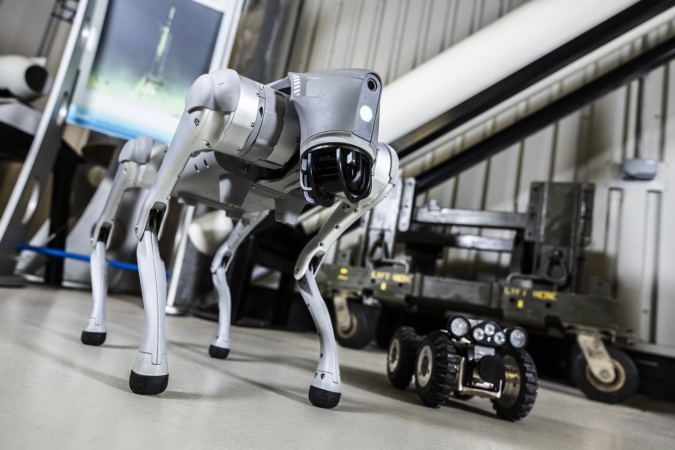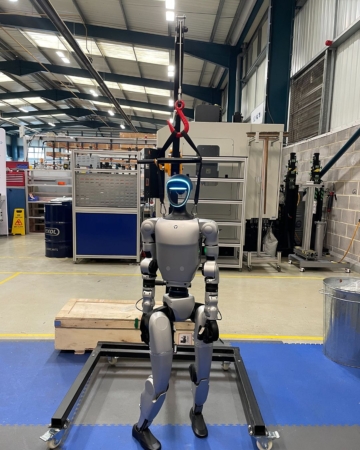How robots keep our people safe:
Here at AWE, in a move towards smarter and safer workplaces, we recently unveiled that we have added robot dogs (otherwise known as quadruped robots) to our elite force to enhance safety, efficiency and data collection. We have launched our first Cobot (Collaborative Robot) and are investigating how we can use humanoid robots to keep our people safe.
Why use robotic dogs?
Robot dogs aren’t just man’s best friend; they’re practical safety partners. They can detect toxic gases, monitor structural integrity and assess debris without putting human lives at risk. Our agile, four-legged robot friends are equipped with advanced sensors, AI-driven navigation, and real-time data analytics. Their mission: to prevent accidents, monitor conditions, and support our human employees.
Robot dogs are equipped with a sophisticated array of sensors, 360-degree cameras, and other data collection devices that enable them to navigate complex construction environments. Their agile mobility allows them to do things such as climb stairs and access hard-to-reach areas, providing unparalleled flexibility in data collection.
We are also looking into other uses for our robots such as the autonomous monitoring of machinery, so we’d essentially have either a wheeled robot or quadruped doing routine laps around the facility and checking or sensing the vibration of the machines. The robot would then send the data to the operator when required so that they can flag up any inconsistent data or abnormalities which can then be assessed.
One of the most valuable features of robot dogs is data mapping and surveying. Our robots can capture detailed information about a construction site from various perspectives and generate complex datasets. Using data mapping, robot dogs can scan our site to minimise our employees being faced with hazardous or challenging environments.
Data mapping video:
The data collected by our robot dogs could be used for many purposes. Currently our site at Aldermaston is undertaking major building work as part of its transformation, so data retrieved from the robot dog could be used to optimise layout and logistics. Architects could then use the data in their design process, while allowing project managers to focus on progress and identify potential issues, and safety professionals can assess any risks involved.

To learn more, we spoke to Jared, who is one of our engineers. Jared joined AWE in 2020 on our graduate scheme, where one of his placements was in the robotics team which involved investigating Exoskeleton technology.
Jared’s placement eventually led him to joining the team on a full-time basis which enabled him to investigate robot dogs and how they work.
“We’ve got three robot dogs, the first was called ‘Neutron’ and then we added two upgraded versions called ‘Proton’ and ‘Electron’. They are all controlled with a WiFi handset (similar to a games console), but the newer models also have the added feature of LIDAR (Light Detection and Ranging) which generates 3D maps and models.”
“We looked to the quadruped systems for decommissioning some of our buildings, mainly because in some areas there might be some debris where a wheeled robot won’t be able to traverse over, or it might get stuck. Having legs would enable it to climb over certain debris and get to those harder to reach areas.”
“The main benefit is removing the person from any potential hazards as the robots can ‘scout’ the area beforehand which allows for planning and sufficient safety arrangements to be made before a person enters the building.”
“There is potential that the robots could clear some things themselves, however that would be further down the line and would require robot arm integration with the dogs and ROVs (Remotely Operated Vehicles).”

We were impressed to hear how the team has used the robots in new ways.
“Robot dogs can carry a lot more weight so we can attach scanners, sensors, cameras. Not only do they find hazards and debris through visual scanning, but they can also measure for toxic fumes too, with the right attachments”, Jared explained.

“The other robots are again in the Research and Development stage, the robot arm is our first Cobot (Collaborative Robot) and we’ll be developing proof of concept solutions with it as it is a good size and has a good payload for grasping/picking up things.”
“The Collaborative Robot ‘Cobot’ can be used for remote manipulation, automation tasks, pick and place tasks, assisted assembly tasks. It is typically bolted onto a table or a trolley, depending on what task it is set up for. Currently, we’ve just got the one small robot arm in our team, that’ll allow us to start proving some concepts and conduct smaller tasks, which will feed into bigger automation projects.”

“The humanoid robot is similar, as with the robot dogs we are mainly investigating how they work, what its limitations are, but possibly looking at teleoperation activities.”
Case Study

Meet Proteus who is our super cool wheeled robot! Proteus has carried out a couple of decommissioning exercises so far and we are planning a test decommission using our robot dogs in one of the non-hazardous facilities.
Proteus is designed to go into our hazardous buildings with a high quality 360 camera installed on its back alongside it’s main camera which we use to navigate with. Proteus is used to enter buildings which aren’t structurally safe for people to enter, so it is used for the first inspection before sending people in.
“Proteus’ has been doing a lot of our decommissioning work and although not as agile as ‘Proton’, it can get into smaller spaces and doesn’t need programming.” – Jared
Prior to any works, if we were to put a human in there, we would have to get scaffolding in place to ensure that the building remains secure. Using robots is now part of the assessment process of buildings, not to replace people doing that job, but to aid our people by ensuring that the buildings are safe.
What’s next?
At AWE we see more robots working with us in the future mainly because of the environment that we work in. They will reduce the risk of danger to our workforce and will save time and money whilst doing so.
As part of our journey exploring the potential safety applications for robots, last month we joined the Robotics and Artificial Intelligence Collaboration (RAICo), a joint programme with the UK Atomic Energy Authority, the Nuclear Decommissioning Authority, Sellafield Ltd, and the University of Manchester. RAICo was established to solve shared nuclear decommissioning and fusion engineering challenges by accelerating deployment of robotics and AI. It brings together the UK’s leading robotics and AI experts with users from across the nuclear decommissioning industry facing real problems today. Being part of this collaboration means we have access to a huge range of UK robotics expertise and new academic research to draw from when determining how we can keep everyone at AWE safe. It’s an exciting opportunity to expand the scope of what we do with robotics and work alongside other organisations seeking the same outcomes.
The future technology we dreamed of growing up is now the technology of today. By continuing to learn and build on this current technology, we prepare ourselves for whatever comes next—a mindset that is essential for a company like AWE.



